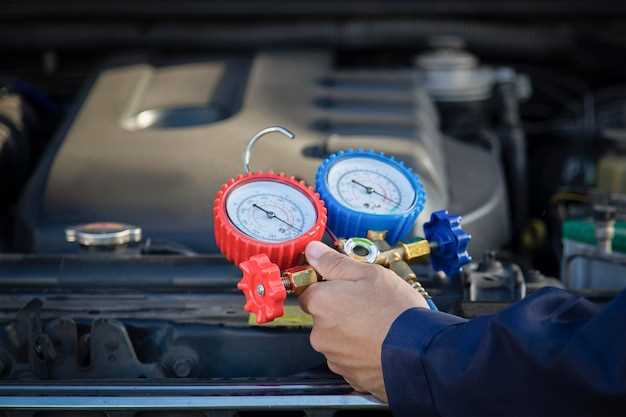
A well-functioning air conditioning (AC) system is essential for a comfortable driving experience, especially in hot weather. Over time, the refrigerant levels in your car’s AC system can diminish due to leaks or normal wear and tear. Consequently, recharging the system becomes necessary to restore its efficiency and ensure adequate cooling. Understanding how to properly recharge your car’s AC system can save you time and money, as well as help maintain the longevity of your vehicle.
Before delving into the recharging process, it’s crucial to know some key components of your vehicle’s AC system. The system operates using a refrigerant–a fluid that absorbs heat from the interior of the car and releases it outside. Over time, the refrigerant can escape through worn-out seals or hoses, leading to decreased cooling performance. It is recommended to check the refrigerant levels annually and recharge the system as needed.
This article will guide you through the steps necessary to safely and effectively recharge your car AC system. We will cover the tools required, the signs that indicate a need for recharging, and step-by-step instructions to ensure that the job is done correctly. Whether you are a seasoned mechanic or a novice car owner, understanding how to manage your AC system can contribute to a comfortable driving experience and minimize repair costs in the long run.
Identifying the Signs of Low Refrigerant Levels
Recognizing the signs of low refrigerant levels in your car’s air conditioning system is crucial for maintaining optimal performance. One of the most common indications is insufficient cooling. If the air blowing from the vents is not as cold as it used to be, it may be a sign that the refrigerant is low.
Another symptom to watch for is the presence of ice forming on the evaporator or the refrigerant lines. When refrigerant levels drop, the pressure in the system decreases, leading to temperatures that can cause freezing. This can result in restricted airflow and even damage to components if not addressed.
You might also notice unusual noises coming from the AC compressor. If the system is low on refrigerant, the compressor may struggle to function effectively, causing it to make hissing, clanking, or rattling sounds as it tries to operate. This can be indicative of a deeper issue within the system that needs attention.
Additionally, frequent on-and-off cycling of the AC system can be a sign of low refrigerant levels. A well-functioning system maintains a consistent temperature, while low refrigerant can cause the system to repeatedly engage and disengage as it fails to reach the desired cooling temperature.
Lastly, an increase in humidity levels inside the vehicle can be a red flag. The air conditioning system not only cools the air but also dehumidifies it. If the cabin feels more humid than usual, this may indicate that the AC system is not operating effectively due to a refrigerant shortage.
Gathering Necessary Tools for AC Recharge
Before beginning the process of recharging your car’s AC system, it’s essential to gather all the necessary tools to ensure a smooth and efficient operation. Here is a list of items you will need:
1. AC Recharge Kit: This kit typically includes a can of refrigerant, a charging hose, and sometimes a gauge to measure pressure. Make sure the refrigerant is compatible with your vehicle’s AC system, usually R-134a or R-1234yf.
2. Manifold Gauge Set: For a more accurate assessment of the AC system’s pressure, a manifold gauge set is invaluable. This tool provides separate pressure readings for both the high and low sides of the AC system, allowing for a comprehensive diagnosis before recharging.
3. Refrigerant Scale: If your kit does not include a way to measure the amount of refrigerant being added, a refrigerant scale will help ensure you are adding the correct amount. Overcharging can lead to system damage.
4. Safety Goggles and Gloves: Working with refrigerants can be hazardous. Always wear safety goggles and gloves to protect your eyes and skin from potential leaks or spills.
5. Thermometer: A digital thermometer can help you measure the temperature of the air coming from the vents before and after the recharge, providing a clear indication of whether the process has improved the cooling efficiency.
6. Basic Hand Tools: Depending on your vehicle, you may need wrenches or screwdrivers to access the AC service ports or make any necessary repairs during the recharge process.
7. Vacuum Pump: If you plan to evacuate the system before recharging, a vacuum pump is necessary. This tool removes moisture and air, which can corrupt the refrigerant and affect system performance.
Gathering these tools will prepare you for a successful AC recharge. Ensuring you have everything before you start will help you avoid interruptions and complete the task efficiently.
Understanding the Refrigerant Types and Compatibility

When recharging your car’s AC system, it is crucial to understand the different types of refrigerants and their compatibility with your vehicle’s system. Using the wrong refrigerant can lead to inefficiencies, system damage, and costly repairs.
The two most common types of refrigerants found in automotive AC systems are R-134a and R-1234yf.
-
R-134a:
- Introduced in the early 1990s as a replacement for R-12.
- Widely used in most vehicles manufactured before 2017.
- Non-ozone depleting but has a global warming potential (GWP).
- Compatible with mineral oil and PAG oil lubricants.
-
R-1234yf:
- Developed to meet newer environmental regulations.
- Primarily used in vehicles manufactured from 2017 onwards.
- Lower GWP compared to R-134a, making it more environmentally friendly.
- Compatible with specific PAG lubricants, but not with mineral oils.
To ensure proper functioning of your AC system, it’s essential to identify which refrigerant your vehicle requires. This information can typically be found in the owner’s manual or on a label located under the hood.
-
Identifying the Refrigerant:
- Check the vehicle’s owner’s manual for specifications.
- Look for the AC system label under the hood detailing the type of refrigerant used.
-
Confirming Compatibility:
- Do not mix different types of refrigerants, as this can lead to system failure.
- Use only the refrigerant specified by the manufacturer for your vehicle model.
If you are unsure about the refrigerant type, consult a professional mechanic or an AC specialist to avoid potential complications during the recharging process.
Step-by-Step Process of Connecting the AC Recharge Kit
Before starting, ensure you have a proper AC recharge kit designed for your vehicle’s system. Make sure to wear safety goggles and gloves for protection.
1. Locate the AC Service Ports: Open the hood of your car and identify the low-pressure and high-pressure service ports. The low-pressure port is typically located on the larger diameter aluminum tubing leading to the compressor. The high-pressure port is on the smaller tubing.
2. Prepare the Recharge Kit: Before connecting the kit, read the manufacturer’s instructions carefully. Ensure you have the correct refrigerant type that is recommended for your vehicle.
3. Attach the Low-Pressure Hose: Take the low-pressure hose from the AC recharge kit and remove the cap from the low-pressure port. Align the connector on the hose with the port, and securely attach it by pressing down until you hear a click.
4. Check the Pressure: With the hose connected, check the pressure gauge on the recharge kit. If the pressure is below the recommended level, it indicates that recharging is necessary.
5. Start the Engine and Turn on the AC: Start your engine and set the air conditioning to the highest setting. This allows the refrigerant to flow through the system while recharging.
6. Start the Recharge Process: Open the valve on the low-pressure hose to allow refrigerant to flow into the AC system. Monitor the pressure gauge; it should rise to the optimal level as the refrigerant is added.
7. Close the Valve and Remove the Hose: Once the correct pressure is reached, close the valve on the hose. Carefully disconnect the low-pressure hose from the service port, ensuring no refrigerant escapes. Replace the port cap securely.
8. Check for Leaks: Inspect the hose connection and service port for any signs of leaks. This can be done by applying a soapy water solution to the area and looking for bubbles.
9. Final Checks: Turn off the engine and clear any tools or extra equipment from the engine bay. Monitor the air temperature inside the car to ensure the AC is functioning properly after the recharge.
Monitoring Pressure Levels During the Recharge Process
During the recharging of your car’s air conditioning (AC) system, it is crucial to monitor pressure levels to ensure optimal performance and prevent damage. The AC system operates under specific pressure ranges, which vary between the low-pressure and high-pressure sides. Understanding these pressures is key to a successful recharge.
First, connect the pressure gauges to the service ports–typically found on the high and low-pressure sides of the system. The low-pressure side should generally display a reading between 25 to 45 psi when the AC is running. Conversely, the high-pressure side can range from 150 to 250 psi, depending on the ambient temperature.
As you begin the recharge process, observe the gauges closely. If the low side pressure is significantly lower than the normal range, it may indicate a leak or low refrigerant levels. In such cases, you should not proceed with recharging until the underlying issue is addressed. On the other hand, if the high side pressure exceeds the recommended limits, it could signal an obstruction or overcharging, which can lead to compressor failure.
While recharging, gradually add refrigerant and keep track of the changes in pressure readings. Ensure that the gauges are stabilizing within the necessary range throughout the process. If the pressures remain outside of the specified ranges, halt the recharge and troubleshoot the AC system further.
Finally, after the recharge is complete, monitor the pressure levels again once the system stabilizes. This final check helps confirm proper functionality and indicates that the recharge was successful. Maintaining proper pressure levels not only enhances system efficiency but also extends the life of your AC components.
Testing the System After Recharging for Optimal Performance
After recharging your car’s air conditioning system, it is essential to test the system to ensure it operates efficiently and effectively. The following steps will help you assess the performance of your AC system after recharging.
First, start your vehicle and let it idle for a few minutes to allow the system to stabilize. Set the thermostat to the lowest temperature setting and turn the AC on to max. It is important to observe various indicators to evaluate performance.
| Indicator | What to Check | Expected Result |
|---|---|---|
| Air Temperature | Use a thermometer to measure the air coming from the vents. | The temperature should be between 35°F and 55°F (1.6°C and 12.8°C). |
| Compressor Operation | Listen for the compressor engaging and disengaging. | The compressor should cycle on and off smoothly without excessive noise. |
| Vents Performance | Check for strong airflow at the vents. | Airflow should be strong and consistent; weak airflow may indicate blockages or issues. |
| Refrigerant Levels | Check the pressure gauges on the AC system. | Pressure should be within the manufacturer’s specified range; consult the vehicle’s manual. |
| Humidity Control | Assess the system’s ability to reduce humidity levels inside the cabin. | Cabin should feel cool and less humid; condensation may form on the windows. |
If any of these performance checks do not meet expectations, further investigation is required. Possible issues can include refrigerant leaks, compressor problems, or blockages in the system. Regular maintenance and timely repairs will ensure your air conditioning system operates effectively throughout its lifespan.
By systematically evaluating these elements, you can determine if your AC system is functioning optimally and take any necessary corrective actions. Proper testing post-recharge will lead to a more comfortable driving experience and longer-lasting system performance.















